|
|
|
The cities are changing daily with the rapid urbanization due to the people moving to cities from rural areas. The current world population of 7.6 billion, (expected to reach 8.6 billion in 2030 and 9.8 billion in 2050) more people live in urban areas than in rural areas (55% of the world's population residing in urban areas in 2018). Thirty percent of the world's population was urban in 1950 and it will proliferate up to 68% of the world's population by 2050. The overall population increase and the upward shift in the percentage living in urban areas are the two key factors for this rapid urbanization. Almost 90% of this population growth happening in Asia and Africa. India, China and Nigeria are expected to account for 35% of the growth in the world's urban population between 2018 and 2050 adding 416 million urban dwellers from India, 255 million from China and 189 million from Nigeria. (World Urbanization Prospects, 2018) Inevitable expansion of urban forms which currently occupy 3% of the global land surface consuming over 75% of the overall energy consumption and producing over 50% of the global waste remains a question in sustainability. It is impossible to neglect the fact that there are no non-urbanized developed countries as the cities contribute over 80% of the global GDP being the major economic and financial hubs. (Cheshmehzangi, 2016) In order to cope with the increasing population in cities, the interest in high-density development or vertical urbanism has been the norm. Unfortunately, all the cities in the world are not prepared to integrate tall buildings, as these buildings may aggravate the challenges in sustainability including traffic congestion, overcrowding, higher environmental pollution and depletion of social wellbeing and etc. It will create another type of sprawl, a"vertical sprawl", which could have worse consequences than"horizontal sprawl". Mumbai in India and Beijing in China are two main cities that agglomerate these ill effects creating environments where the increasing poisonous air has become the fastest growing cause of death. (Vidal, 2018) The latest news coming from New Delhi is that 89 per cent people in Delhi feel discomfort due to air pollution where the air quality index has been recorded on 13th November 2018 as 406 (severe). The top four causes of this situation has been identified as motor vehicles (74 per cent), industrial units (58 per cent), tree cutting (56.9 per cent) and construction activities (48.2 per cent)(Check, 2018) |

Eng. Upeksha Virajini Karunathilake
Eng. Shiromal Fernando |

According to Bogunovich and Budgett (2014) an ideal urban form is encouraged, which balances all the four agendas; 'prosperity', 'affordability', 'liveability' and 'sustainability' which can be represented as a conceptual model of a square pyramid as shown in figure 2
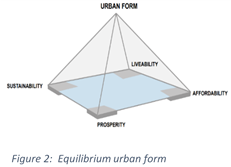
Therefore, the economic viability must not be the only factor in a sustainable urban form but the one which is enclosed in the social domain and overall in ecological domain where the strong sustainability principles apply. (Figure 3) This concept elaborates that all human life and activity occurs within the boundaries of the planet Earth (Biosphere) where humankind lives, including all societal functions, such as the economy. There is no society, (sociosphere) without planet (biosphere) and no social functions without economy (Ecosphere). Therefore this concept must be applied in the development projects specially, in Sri Lanka to assist a sustainable future.
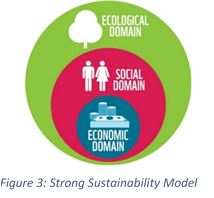
Livability is a concept which is clearly more a qualitative construct representing a set of characteristics that relate to the attractiveness of an area as a 'desirable' place to live, work, invest, and conduct business (Giap et al., 2014).
This term 'Livable cities' has appeared in during the 1980s with more concern given to the environment and increasing competition among cities in attracting foreign investment(Kashef, 2016). Various rankings were started to be published annually to quantify the level of livability as a reference to the quality of life in a specific locality. Economist Intelligence Unit's livability ranking (EIU) the Mercer Quality of Living Survey and the Organization for Economic Cooperation and Development's (OECD) Better Life Index (BLI) are some prominent livability indices available. Modern cities like Melbourne (Australia), Vienna (Austria), Vancouver, Toronto (Canada) and Auckland (New Zealand) have been in the top 10 livable cities in the world for several years according to those livability rankings. As a whole, a livable city consists of long-term stability with good security, healthcare, good culture and environment, education and infrastructure. (The Global Livability Index, 2018)
Each category has its own indicators to evaluate the livability in a city and different weightages have been given in EIU Livability Index. The strategies to enhance the livability in Colombo Sri Lanka in those categories will be discussed in this paper.
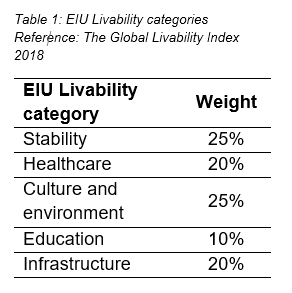
Urbanization in Colombo, Sri Lanka
As stated in the World Bank Report- Leveraging Urbanization in South Asia: Managing Spatial Transformation for Prosperity and Livability 2015, Sri Lanka's cities appear unattractive to potential migrants from rural areas due to poor urban living conditions. The report further highlights that Sri Lanka has a 'Messy' urban characteristics where the share of Sri Lanka's urban population living below the national poverty line in 2012 was only 2.1%, while the share of the urban population living in slums is among the lowest in South Asia (Ellis et al. 2016). Sri Lanka demonstrates a sprawl and ribbon development where the expansion of urban areas is more than the growth of the urban population. The hidden urbanization in Sri Lanka reveals that as much as one-third of Sri Lanka's entire population may be living in areas that possess urban characteristics but are classified as rural. Anyway, Colombo, Sri Lanka was in the five biggest improvers within last five years before 2018. The 2018 livability index of the Economist Intelligence Unit ranked Colombo 130 out of 140 cities, but it is in a backward trend compared to 2017 rank, 124. Historical records reveal that Colombo, Sri Lanka has been recorded within the bottom ten cities in 2011 with a rank of 131(A Summary of the Liveability Ranking and Overview, 2011)
.Therefore, it is obvious that the City of Colombo is in a risk of depletion of the livability even if the skyline is changing erecting skyscrapers within the City limits.
Environmental Impacts of Urbanization in Colombo
The rapid urban development replaces the natural vegetation with impervious surfaces such as buildings, parking lots, roads, and pavements. The depletion of this natural surfaces covered with vegetation improves the surface urban heat island (SUHI) effect increasing the Land Surface Temperature (LST) as shown in the figure 4 which is a result of the research conducted by Ranagalage et al. (2017) confirming the strong influence of urbanization on the formation of surface urban heat island (SUHI) effect in the Colombo Municipal Area (CMA). As stated by Lin et al. (2016) the green space in Colombo District Sectratiant Division was 4.383km2 in 2015. It was as a result of the decrement of 23.64% from 2008 value. Assuming the rate of change is uniform, the existing green cover in Colombo District Sectratiant Division by now (2018) is less than 3.8km2. But, unfortunately, the increased rate of development further depletes the available green spaces within Colombo city.
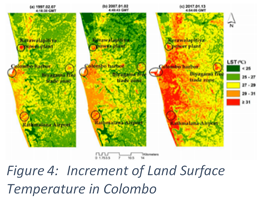
which is extremely less than the proposed value of 1:8. Therefore, It is obvious that the way Sri Lanka is moving through urban development is no more sustainable but will be another Mumbai or Beijing in the near future.
The above revealed impacts can be mitigated through several sustainable strategies which can be involved in upcoming and ongoing development plans in the city of Colombo. The ability of embedding the livability enhancement techniques in accordance to the principle of Strong Sustainability will be discussed here onwards.
01. Vertical Development embedded with higher Green Plot Ratio
Colombo city (CMC) accounts for 15% of total urban residential population in Sri Lanka which is 580650 (2018) (World Urbanization Prospects- File 19, 2018) with over 1.5 Million floating population and it will increase up to around 679 200 by 2030 with even more floating population. By 2050, it will exceed one million (Razcik, 2015). The space for accommodating the increasing population will be a crucial factor where the high density development becomes the only solution. In 37.3 km2s of land, the density will increase over 26000 people/km2. With this high density development, the daily traffic added on roads will increase considerably. But, involvement of mix developments will be able to mitigate this impact as the necessity of traveling is limited when the work and living places are located in the same building or nearby. This will create a family oriented society again minimizing lot of social issues. Accommodating the infrastructure like water and electricity will be less complicated with vertical development. Livability is also
improved with optimized quality of infrastructure related to vertical living.
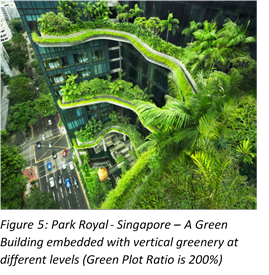 The mix development can be embedded with sufficient greenery, where people can experience nature within a high-rise building itself. In order to assist the green areas within built environment, different strategies like green roofs, sky bridges and green walls can be accommodated at different levels of the building as shown in Figure 5. This vertical greenery concept has been a new trend in developed countries like Australia and Singapore. These features will be really contributive in the process of green rating while providing invaluable benefits such as improved thermal performance, carbon sequestration, storm water management and reduction of heat island effect. They will make the city an aesthetically pleasing environment improving the biodiversity as well. Every breath taken by human will be clean and fresh. Livability is improved supporting a sustainable culture and environment created through pleasing microclimate within the building. Another strategy of creating a livable city is to utilize each and every inch of land. The environmentalists, Siang and Ang (2016 propose that the ownership of the unused lands, boundaries and land spaces beside the roads etc. should be properly distributed among the community to develop them into green spaces or landscapes that are well maintained. This will improve the social interaction and also enhance the environmental quality.
The mix development can be embedded with sufficient greenery, where people can experience nature within a high-rise building itself. In order to assist the green areas within built environment, different strategies like green roofs, sky bridges and green walls can be accommodated at different levels of the building as shown in Figure 5. This vertical greenery concept has been a new trend in developed countries like Australia and Singapore. These features will be really contributive in the process of green rating while providing invaluable benefits such as improved thermal performance, carbon sequestration, storm water management and reduction of heat island effect. They will make the city an aesthetically pleasing environment improving the biodiversity as well. Every breath taken by human will be clean and fresh. Livability is improved supporting a sustainable culture and environment created through pleasing microclimate within the building. Another strategy of creating a livable city is to utilize each and every inch of land. The environmentalists, Siang and Ang (2016 propose that the ownership of the unused lands, boundaries and land spaces beside the roads etc. should be properly distributed among the community to develop them into green spaces or landscapes that are well maintained. This will improve the social interaction and also enhance the environmental quality.
A city without good food is not a livable city at all. It should be self-sufficient by providing the food by itself. Urban food production involves the access to healthy food for people. This will support the healthcare aspect of people minimizing the need of doctors or the healthcare centres. Grown nearby it minimizes the carbon footprint involved in food supply chain as there is no carbon emission related to transportation. Innovative thinking of people will be improved through investigating different methods of growing. As a result of that, growing not only on land but also on roofs and walls have been an evolutionary trend in most of the developed countries. Located near the equator gifted with 12/7th of sunlight for 24/7th Sri Lankan must be able to implement this concept in their buildings.
02. Involving Green Building Techniques
Green Building Concept is the only approach that will contribute buildings towards sustainability or making the city livable. The buildings should be built in accordance to any Green Rating Tool, which leads built environments to eco- friendly while improving the social environment and also the economic benefits. The Green House Gas emissions are properly minimized while increasing the efficiency of the building. Vertical living enables the access to the natural resources such as wind and sunlight which can be effectively utilized for energy generation. Photovoltaic panels can be embedded to roof and facade of high-rise buildings while placing wind turbines to generate power from wind at higher levels. These strategies can be further involved in Net Zero Energy Buildings where more energy is produced by the building itself than the amount it consumes. Living in 21st century we are able to experience the rapidly upgrading technology in each and every field. This makes the people's life easier and more comfortable. The smart devices can be embedded in buildings too where the buildings we live identify our comfort condition and adjust the environment to make us more and more comfortable. Anyone would love to live in such an environment. This concept supports to enhance the livability in environmental and infrastructure aspects while improving the mental and physical health of people who live in such buildings. Likewise, green building techniques sustain ecological domain while strengthening the social health. Effective use of passive sources will save cost supporting economic sustainability.
03. Enhancement of the Mobility
When making a livable city, improvement of the mobility is also important. Heavily congested roads with a lot of carbon emissions don't make a livable environment. The interest of traveling on private vehicles is the major barrier in this matter and the public transport is the only solution. If there is a quality public transport network with improved accessibility to different locations inside the city will make people hesitate to use their own vehicles. Reducing the road development, internal rail network establishment for trams or transits will save a lot of materials and carbon emissions while improving the mobility. Green modes of transport such as bicycles, carpooling, walking etc. can be promoted within the city. Public transportation modes also can reduce the space allocated for roads and can replace them with natural landscape areas which purify the breathing air contributing to a livable city.Reduction of emissions and erection of different modes of transport support enhancing the environmental quality and infrastructure.
04. Improvement of mental and physical health
 Healthy city with energetic and youthful community will be supported by enhancing the infrastructure for physical activities like jogging and cycling at no cost. Also, it is really important to provide walkable spaces within a city so that people are encouraged to walk within a city. The environment beside the path should provide a unique experience to the users. The lush presence of green landscape will be really beneficial as it improves the mental health of the users as well. Supporting the physical health as above, the mental health can be maintained in the city by including reasons to have a sense of humour. Uncommon and attractive arts and crafts which bring a smile to anyone's face can be located at different locations of the city. Colourful environments create festive mood making the hearts filled full of joy that improves the mental health of people.
Healthy city with energetic and youthful community will be supported by enhancing the infrastructure for physical activities like jogging and cycling at no cost. Also, it is really important to provide walkable spaces within a city so that people are encouraged to walk within a city. The environment beside the path should provide a unique experience to the users. The lush presence of green landscape will be really beneficial as it improves the mental health of the users as well. Supporting the physical health as above, the mental health can be maintained in the city by including reasons to have a sense of humour. Uncommon and attractive arts and crafts which bring a smile to anyone's face can be located at different locations of the city. Colourful environments create festive mood making the hearts filled full of joy that improves the mental health of people.
Also the calm and quite environments should be established strategically locating religious places and memorable places within the city. A community which follows any religion is a valuable source to a developing country like Sri Lanka where the citizens begin to learn above the life and the world using both brain and heart.
05. Improvement of Social interaction
city where people can gather and enjoy. It will create a friendly environment and people will be attracted to such cities while livability is improved. Pleasing environments besides the roads connecting cities will encourage someone to have a walk along that.
Existing environment should be preserved in developing a city as the greenery and the natural landscape features enhance the value of the city. If a city is full of above-mentioned characteristics, it will act against the virtual interaction involved with mobile phones and which has become a major threat to the physical attraction. People will feel that they are living on this earth and will love the city they live.
06. Enhanced Security
Enhanced security is one of the major component of a livable city which makes even a visitor to the city feel safe and not alone. Each and every person in the city will be protected with good security system with a loyal service to the people. Proper network of security cameras, security points throughout the city and proper rules and regulations with a fine system for those who neglect the rules are main strategies to improve the security of the city leading towards a livable city. The environment providing directions will take care of the people supporting them to move wherever they want within the city.
Finally it can be concluded that, the inevitable increase of population has been the major reason behind rapid urbanization where people migrate to cities to live, work and play within the same region. But, this relentless change has moved the world towards a disaster as the built environment in cities does not support livable environment. Colombo, Sri Lanka also has been identified as a rapidly urbanizing city in South Asia which is also leading towards non- livable built environment decreasing the livability. Therefore, this article discusses the possibility of enhancing the livability of the city identifying Strong Sustainability Principle as the key towards this sustainable development.
References
Cheshmehzangi, Ali. (2016)."City Enhancement beyond the Notion of 'Sustainable City': Introduction to Integrated Assessment for City Enhancement (IACE) Toolkit." Energy Procedia 104: 153-58. http://dx.doi.org/10.1016/j.egypro.2016.12.027.
Vidal J. (2013)"Beijing is not the only Asian city with lethal air pollution", Available at: https://www.theguardian.com/environment/blog/2013/jan/17/lethal-air-pollution-asia-cities. (Accessed: 02 November 2018)
Check F. (2018),"It's so sick: 89 per cent people in Delhi feel discomfort due to air pollution", Available at: https://www.indiatoday.in/india/story/delhi-air-qaulity-pollution-major-causes-tree-felling-vehicles-1387891-2018-11-13 (Accessed: 14 November 2018)
Giap et al. (2014),"A new approach to measuring the livability of cities: the Global Livable Cities Index" World Rev Sci Technol Sustain Dev. 2014; 11(2):176. doi:10.1504/WRSTSD.2014.065677
Kashef M. (2016),"Urban livability across disciplinary and professional boundaries", Front Archit Res. 2016;5(2):239-253. doi:10.1016/j.foar.2016.03.003
Munasinghe G. (2013),"Colombo City Development Plan History", Available at: http://townplanninginsrilanka.blogspot.com/2013/02/colombo-development-plan-history.html (Accessed: 07 November 2018)
Ranagalage et al. (2017),"An Urban Heat Island Study of the Colombo Metropolitan Area, Sri Lanka, Based on Landsat Data (1997-2017)". ISPRS Int J Geo-Information. 2017;6(7):189. doi:10.3390/ijgi6070189
Lin L. and Pussella P., "Temporal Changes of Per Capita Green Space of Colombo District, Sri Lanka,"" (2016)
T. Lee Siang and V. Ang, (2017), "Cities of Love", Singapore, World scientific publishing Co. Pte. Ltd, 2017, p. 1-315
Razcik R. (2015),"The changing facade- Making Colombo the 'Miracle of Asia'", Available at: http://www.pressreader.com/sri-lanka/daily-mirror-sri-lanka/20150611/281960311374195 (Accessed: 15 November 2018)

Eng. Upeksha Virajini Karunathilake
Civil and Structural Engineering Consultants (Pvt) Ltd
“Upeksha Virajini, Research Civil Engineer in Sustainability holds the degree of B.Sc. Engineering (Hons) in Civil Engineering from University of Moratuwa, Sri Lanka and also an Associate Member in the Institution of Engineers, Sri Lanka. Being an Associate Green Professional of Green Building Council of Sri Lanka and working in Civil and Structural Engineering Consultants (Pvt) Ltd, Upeksha Virajini focusses on the Sustainability in the Built Environment to contribute transforming the Built Environment towards Climate Resilience."

Eng. Shiromal Fernando
Civil and Structural Engineering Consultants (Pvt) Ltd
“Shiromal Fernando, Leading Structural Engineer, Sri Lanka, best known for his engineering work on many high rise buildings in the country including the 350m tall Lotus Tower, Colombo. He holds the degrees B.Sc. Engineering (Hons) in Civil Engineering & MPhil Degree from the University of Moratuwa, Sri Lanka and is also a Chartered Engineer of the Institution of Engineers, Sri Lanka. As the Managing Director , Shiromal Fernando currently leads Civil & Structural Engineering Consultants Private Ltd. Shiromal Fernando is the current Chairman of CTBUH Sri Lanka and the Vice President of the Green Building Council Sri Lanka since 2010."





